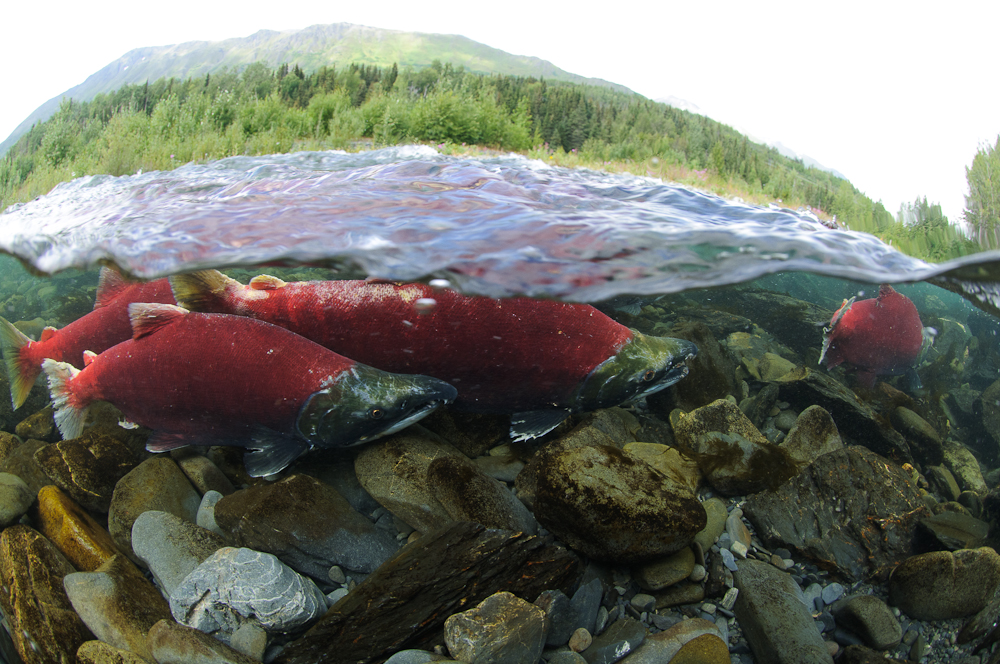Sockeye salmon heading to spawning grounds swim up the Kenai River on Aug. 17, 2008. (Photo by Kentaro Yasui/U.S. Fish and Wildlife Service)
The federal government is sending nearly $12 million to Alaska to address salmon fishery disasters on the Kuskokwim River and in Upper Cook Inlet, Commerce Secretary Gina Raimondo announced on Friday.
The aid money is for disasters declared for the 2022 chum salmon failure on the Kuskokwim River and the 2021-2022 sockeye salmon failure that affected Upper Cook Inlet setnet fishers. Aid for the Kuskokwim River disaster totaled $331,920, while aid for the Upper Cook Inlet sockeye disaster totaled nearly $11.5 million, according to the National Oceanic and Atmospheric Administration, which is a branch of the Commerce Department.
Alaska is not the only state affected by poor salmon returns. Along with Friday’s announcement of aid for those affected by the Alaska salmon disasters, the Commerce Department announced $403,978 in aid for the Port Gamble S’Klallam Tribe’s 2021 Puget Sound fall chum and coho salmon fisheries in Washington state.
“Each year, we see how climate change continues to have severe impacts on the fisheries and ecosystems that are vital to our economy, and the Commerce Department is working to mitigate these impacts,” Raimondo said in a statement issued by NOAA. “This funding will assist with the recovery of salmon fisheries in communities across Alaska and Puget Sound by bolstering fisheries restoration efforts, minimizing the risk of future disasters and helping build back stronger.”
The state government will be responsible for distributing the federal assistance money, NOAA said.
The 2022 Kuskokwim River chum disaster and 2021-2022 Upper Cook Inlet sockeye disaster are among several fishery stock or economic collapses in Alaska in recent years that have been declared by the Department of Commerce and, in turn, addressed with federal financial aid.
Last year, the department allocated $216 million in aid for multiple disasters declared for crab and salmon harvests from 2020 to early 2023. Most of that was to address economic damages from failed Bering Sea crab harvests. Stock crashes forced two consecutive closures of the Bristol Bay red king crab closure in the 2021-22 and 2022-23 seasons and the first-ever closure of the Bering Sea snow crab fishery in 2022.
In 2022, the Commerce Department allocated $131.8 million for salmon, crab and cod disasters occurring between 2018 and 2022, according to the Alaska Department of Fish and Game.
Still pending are Commerce Department decisions about how much aid money to allocate for other recently declared Alaska fishery disasters. Decisions yet to come will address the continued closure of the Bering Sea snow crab fishery for the 2023-2024 season, as well as the declared disasters for the 2022 Chignik salmon fishery and last year’s Upper Cook Inlet setnet sockeye fishery.
The Bristol Bay red king crab harvest resumed late last year, even as the snow crab harvest remained closed, but the allowable catch was very small compared to past years. Scientists say that climate change is posing long-term problems for Bering Sea crab stocks.
GET THE MORNING HEADLINES DELIVERED TO YOUR INBOX
The post Nearly $12 million headed to Alaska in latest infusion of fishery-disaster aid appeared first on Alaska Beacon.

